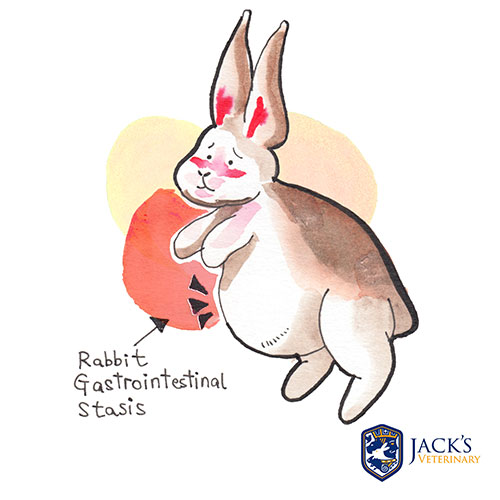Bloggers

I believe that most of the rabbit owners agree that the most common disease in rabbit is gastrointestinal stasis ( GI stasis ). Many owners found their rabbit suddenly ate less and looked dull inside the cage. Some rabbits may stop eating within few hours. Eating less is a signal of life-threatening disease, and this worries owners a lot.
Rabbits are hindgut fermenters and their GI peristalsis requires a lot of fiber and fluid to stimulate to work; therefore, they spend most of their time on eating. Stress or anxiety gives rabbits stress. This stress can cause rabbits to eat less; therefore, their peristalsis slows down and may stop eventually when it gets worse. Their intestines have many yeasts and gut floras for fermentation thus they produce lots of gas. Because rabbits physiologically have no mechanism of vomiting, large amount of gas developed and trapped into the GI tract when peristalsis stops. When their stomach is distended to a huge large size, the aorta and vein will be compressed thus the blood circulation will become poor, resulting in shock, even collapse and death.
Where does a rabbit get stress from? There are many reasons and usually being grouped into 3 categories. All of the reasons below can cause rabbits stress enough to develop GI stasis.
1) Environmental & dietary: noise ( neighbor construction, party ), sudden weather change, sudden diet change, new pets at home, new home, low fiber diet etc.
2) Pain: dental disease, tooth root abscess, osteoarthritis, sore hocks, bladder stones etc.
3) Systemic disease: any severe disease such as severe inflammation, kidney disease, trichobezoar ( hair ball obstructed at the intestines ) etc.
There are 3 grades of rabbit GI stasis according the symptoms and severity of the disease.
Grade 1: slightly reduce of appetite, small size or reduce amount of stool.
Grade 2A: moderate reduce of appetite, small size and/or moderate reduced amount of stool. Mild to moderate stomach distension
Grade 2B: No appetite and stool. Mild to moderate dehydration. Mild to moderate stomach distension.
Grade 3: No appetite and stool. Severe dehydration. Severe stomach distension or impaction.
Veterinarians need to take a long medical history and perform a physical examination on the rabbit. Blood test and radiography are usually recommended to obtain the body condition information such as dehydration status and possible underlying primary cause of the disease.
Each grade of GI stasis requires different medical approach. Grade 2b and 3 are always critical and hospitalization is recommended.
Many rabbit owners mistreat their rabbits at home resulting in death. The most common mistake is feeding GI pro-kinetic which drug is used for a rabbit with GI impaction or obstruction resulting in death quickly at home. Therefore, you should always contact your veterinarian when you notice your rabbit starting to eat less.
Avoiding low fiber diet and pellet is the first step of preventing GI stasis. High fiber can prolong the chewing time thus the best method to prevent dental malocclusion, stress and pain related to GI stasis. Be aware of environmental factors listed above. Comb their hair more frequently when their coat changes seasonally to avoid hair ball obstruction. Regular body check of your rabbit by a veterinarian is the best recommendation of preventing GI stasis.
